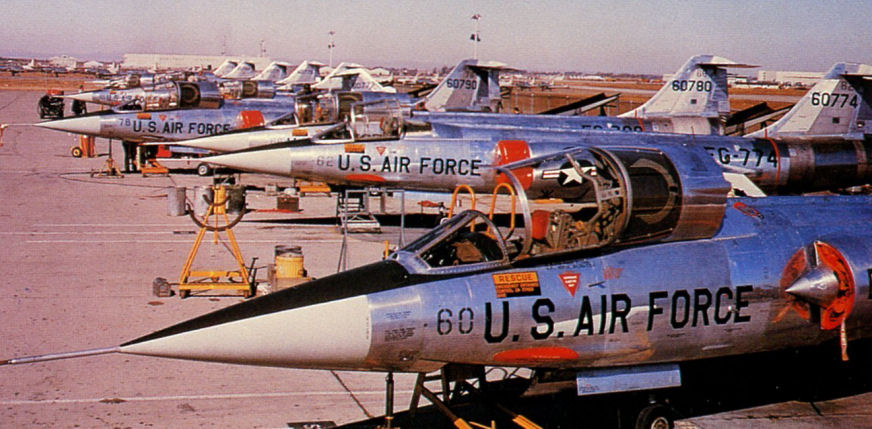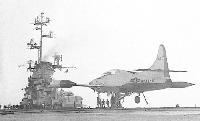
Варианты
T2V-1 SeaStar (позже T-1A): усовершенствованный TV-2 с системой управления пограничным слоем, приподнятой кабиной, предкрылками и закрылками, а также с ТРД Allison J33-A-24 тягой 27,13 кН
Показать полностью- Описание
Фотографии
-
Мировая Авиация 177
В 1953 году Келли Джонсон усовершенствовал популярный T-33. Основной упор был сделан на обеспечение более высокой эффективности взаимодействия инструктора с курсантом и улучшение управляемости машины на малых скоростях. ВМС США приняли машину на вооружение в 1957 году, но там его карьера оказалась недолгой - ввиду различных проблем, в том числе с системой управления.
-
Мировая Авиация 163
T2V-1 SeaStar. Данный T2V-1, шестой из 149 выпущенных, несет знаки Испытательного центра авиации ВМС США и соответствует времени проведения испытаний на авианосце "Энтитем". Оперативно готовые SeaStar стали поступать на авиабазу Корпус-Кристи в Командование усовершенствованной подготовки личного состава авиации ВМС с мая 1957 года.
-
Мировая Авиация 25
Много тайн и надежд окружали F-104 в начальный период его ввода в эксплуатацию. Истребители F-104A, готовящиеся к передаче в ВВС США, были сфотографированы на заводе "Lockheed" в Палмдейле. Глядя на Starfighter, трудно поверить, что он разработан в 1950-х годах (об этом свидетельствуют самолеты T2V Sea Stars для ВМС США на заднем плане).
Другие самолёты на фотографии: Lockheed F-104 Starfighter - США - 1954
-
Air Pictorial 1955-06 / Photos by request
Регистрационный номер: N125D [2] Production model for the U.S.N. of the private venture Model L-245 jet trainer is known as the T2V-1. The wingtip tank at the top belongs to a standard TV-2 (T-33A in the U.S.A.F.).
Другие самолёты на фотографии: Lockheed T-33A - США - 1948
-
Air Pictorial 1956-06
Регистрационный номер: N125D [2] Lockheed T2V-1 SeaStar. Bedecked in the new U.S. Navy training colour scheme of white and orange, the SeaStar is now in production as an advanced, two-seat, jet conversion trainer which will at first supplement and then ,replace the Lockheed TV-2 (T-33A) Shooting Star from which the T2V SeaStar is developed. Powered by a 6,100-lb.s.t. Allison J33-A-22, the SeaStar has almost twice the range of the Shooting Star (T2V - 900 miles) for an a.u.w. of 16,400 lb. and a maximum speed of 600 m.p.h. Span is 42 ft. and length 38 ft. Unusual is the adoption of both U.S. Navy markings and the civil registration N125D.
-
Air Pictorial 1956-11
The Lockheed T2V-1 SeaStar advanced jet-trainer will shortly enter service with the U.S. Navy. This two-seater is powered by a 6,100-lb.s.t. Allison turbojet and has a maximum speed of 600 m.p.h. The T2V-1 is a progressive development of the T-33A Shooting Star (U.S. Navy TV-2).
-
Air Pictorial 1955-10 / The journal of a roving spotter
LOCKHEED T2V-1. Latest development of the well-known Shooting Star series is the T2V-1 or Lockheed Model 245. This machine, now in production for the U.S. Navy, flew for the first time on 15th December 1953 as a private venture. Differences between it and the T-33 include wing suction devices, modified fin, and cockpit, and up-rated engines.
Salient features: A low-wing monoplane. the T2V-1 has an unusual fuselage shape with blunt nose, long transparent canopy, "hump" aft of the canopy, and the long dorsal spline to the fin. The intakes are low set in the fuselage sides. Wings are square cut with large streamlined fuel tanks at the tips. The fin resembles that of the F-94 Starfire and there is a marked lip above the jet efflux. The tailplane is mounted a short way up the fin. Main undercarriage legs retract inwards into the centre section, and the nosewheel folds backwards. -
Мировая Авиация 163
Данный SeaStar получил обозначение YT2V-1 (хотя официально предсерийных машин не было), он сфотографирован во время первой посадки на авианосец "Энтитем".
-
Air Pictorial 1956-12 / P.Bowers - U.S. Navy Aircrafts on Display
Lockheed T2V-1 SeaStar, which is basically an improved and more powerful version of the TV-2 (T-33A) advanced trainer.
-
Air Pictorial 1955-10 / The journal of a roving spotter
LOCKHEED T2V-1. Data: Manufacturer: Lockheed Aircraft Corporation, Burbank, California, U.S.A. Power: one Allison J33-A-16A of 6.350-lb. thrust. Accommodation: two-seat in tandem. Dimensions: span 42 ft.; length 38 ft.; height 13 ft. No other data available.
- Фотографии











